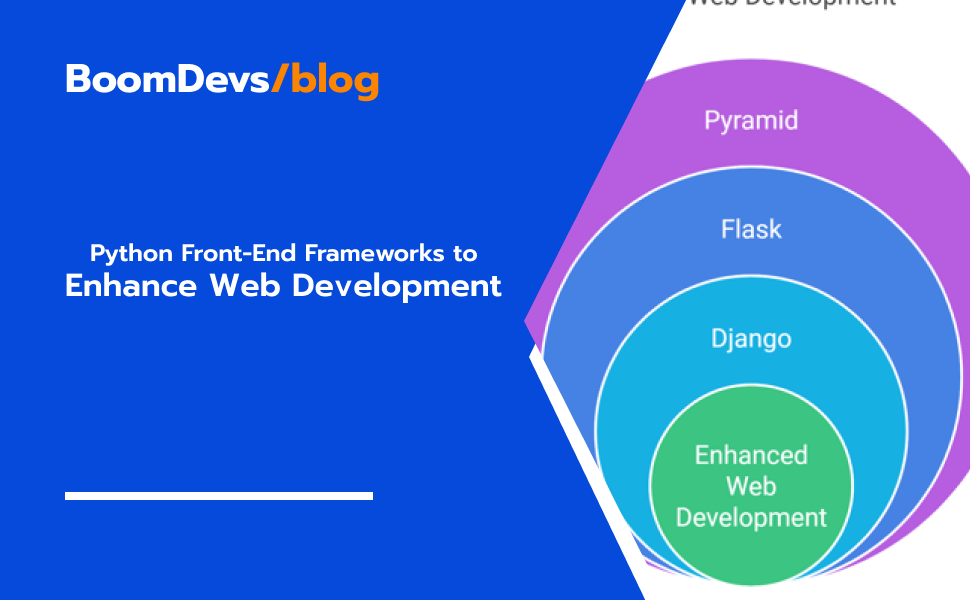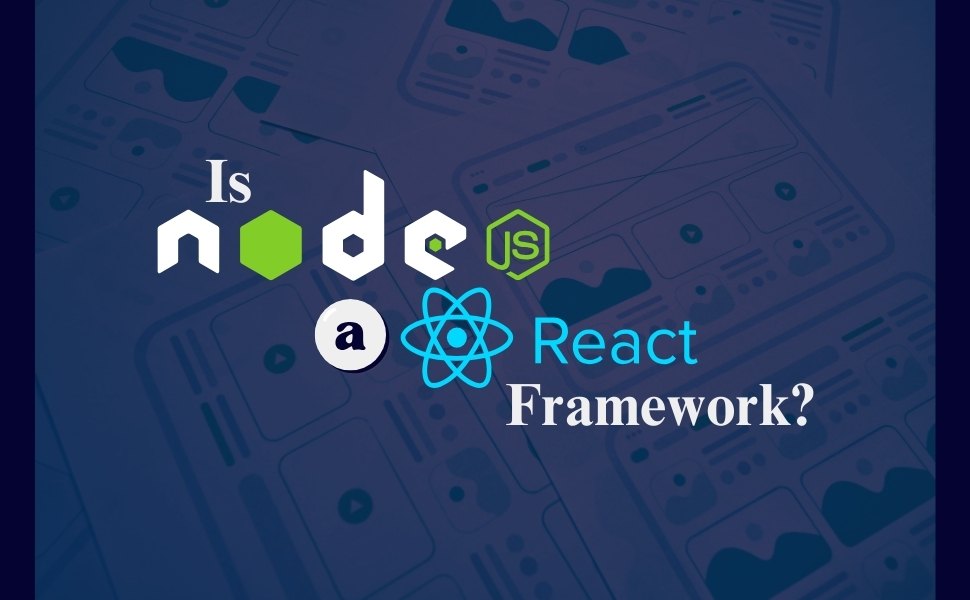Python is well-known for being simple and powerful, especially for back-end development. But did you know you can also use Python Front-End Frameworks for web development? While JavaScript is the main language for the front end, Python has some amazing frameworks that let you use its flexibility and ease for building web interfaces.
If you’re a Python developer who wants to try front-end work or just prefer sticking to Python, this article is here to help. We’ll look at the best Python front-end frameworks you can use. These tools make it easier to build user-friendly websites, save time, and improve your workflow.
Whether you’re creating interactive pages or exploring full-stack development, Python has tools to help you create amazing web projects. Let’s get started!
What Are Python Front-End Frameworks?
Python front-end frameworks are tools that help you use Python to build the parts of a website that people see and interact with. This includes things like buttons, menus, forms, and layouts. While Python is mostly known for back-end tasks like managing data or servers, these frameworks let you combine Python’s simplicity with open-source front-end CSS/HTML frameworks. This makes it easier to create user-friendly and interactive designs for the front end.
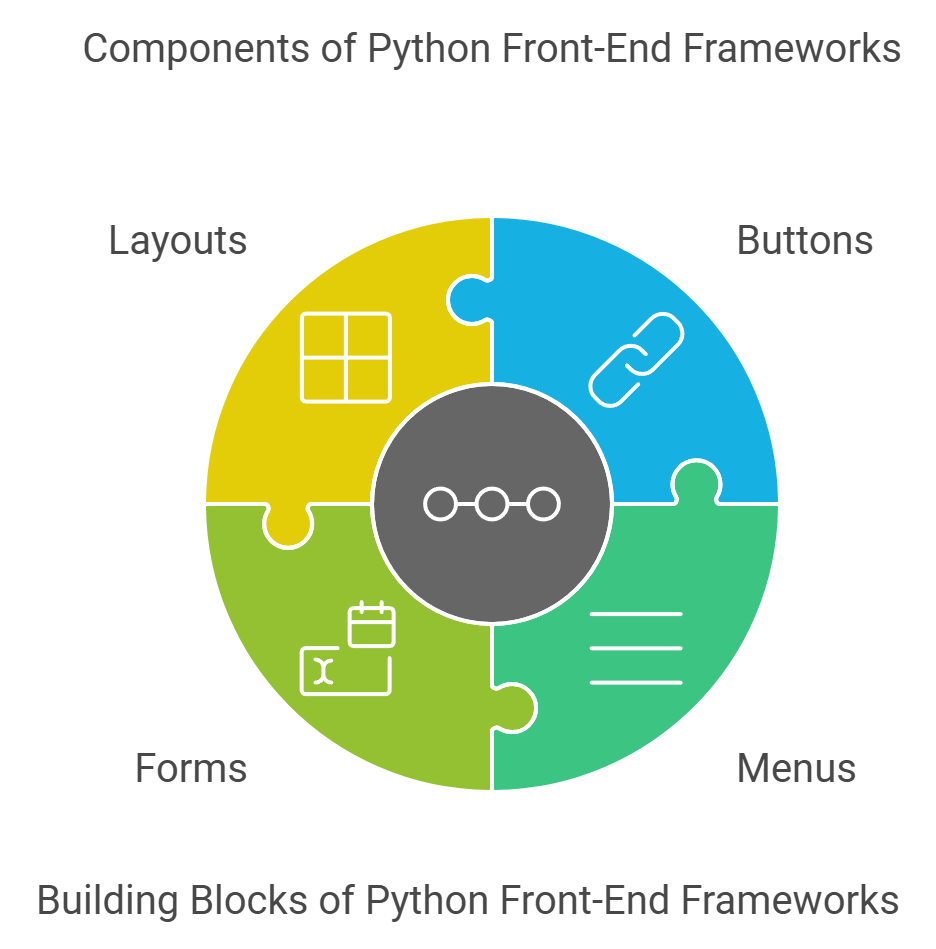
How Are They Different from Back-End Frameworks?
Back-end frameworks like Django and Flask handle the behind-the-scenes work. They manage tasks like data processing, user accounts, and connecting to databases.
Front-end frameworks are different. They focus on what users see in their browser, such as the design, buttons, and layout. Python front-end frameworks allow you to use Python for both the back end and the front-end. This makes it easier for developers to work on both sides of a website using just one language. Many developers find this approach simple and efficient.
How Does Python Work with Browsers?
Python doesn’t run directly in browsers like JavaScript. Instead, it uses special tools to make it work. Frameworks like PyScript and Brython convert Python code so it can run in a browser. Other tools, such as Anvil and Dash, make it easy to build full web applications by handling both the back-end and front-end with Python.
Strengths and Challenges
The best thing about using Python for the front end is how simple it is. Python’s clean and easy-to-read syntax makes it great for beginners and experienced developers alike. When comparing Python vs JavaScript for web development, Python is especially useful if you want to use one language for your whole project, covering both the back end and front end.
However, Python isn’t as fast or widely supported in browsers as JavaScript. This means it might not be the best choice for all projects, especially those that need top-notch performance.
By learning about Python front-end frameworks, you can open up new possibilities for building websites. Whether you’re just starting out or already have experience, these tools make it easier to create interactive and user-friendly web applications.
Types of Python Web Development Frameworks
Python offers a variety of web development frameworks, each designed for different needs. Whether you’re building a user interface, a full-stack application, or something lightweight, there’s a Python framework that can help. Let’s look at some types of frameworks and how they support front-end development.
1. Front-End Focused Frameworks
These frameworks are specifically built to bring Python to the browser. They let you create front-end elements like buttons, forms, and layouts using Python.
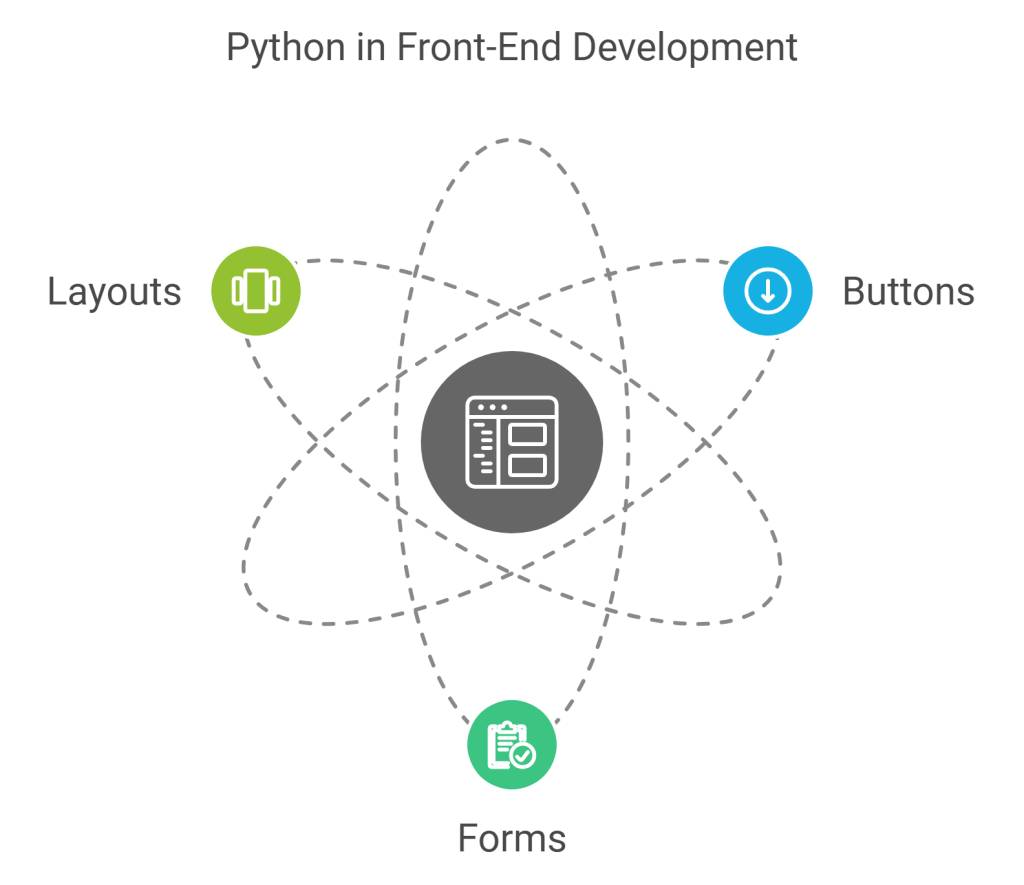
- PyScript: A tool that allows you to write Python directly in HTML, making it simple to integrate Python into front-end tasks.
- Brython: Converts Python code into JavaScript so it can run in the browser. It’s great for developers who prefer Python over JavaScript for creating interactive pages.
- Anvil: A full-stack platform that simplifies web development by letting you design front-end interfaces and back-end logic using only Python.
2. Full-Stack Frameworks with Front-End Capabilities
Full-stack frameworks handle both the back-end and front-end, making them versatile.
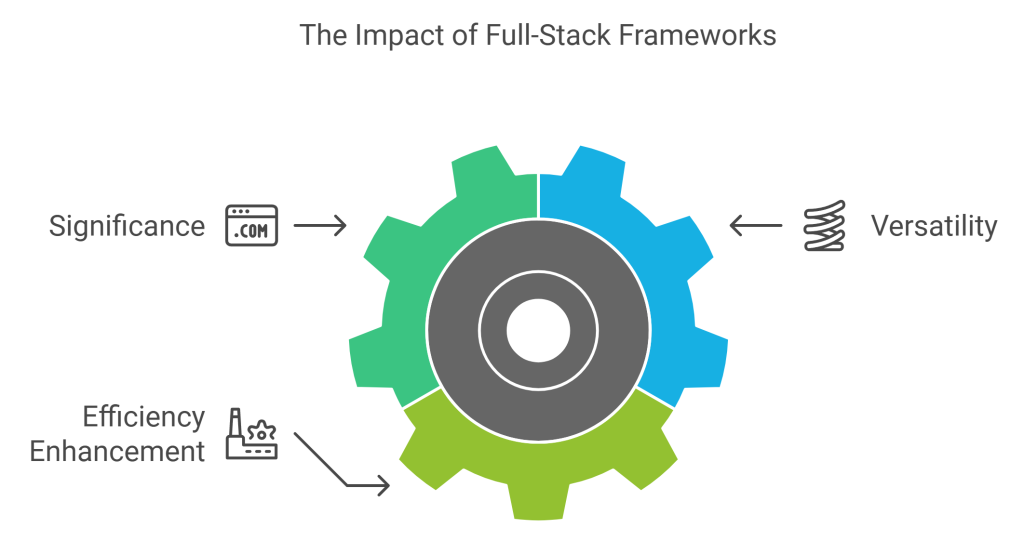
- Django: Known for its powerful back-end capabilities, Django also offers tools like templates and forms to create dynamic front-end features.
- Flask: While Flask is lightweight and back-end focused, it pairs well with front-end libraries, giving developers the freedom to design interactive interfaces.
3. Micro-frameworks for Front-End Use Cases
Micro-frameworks are lightweight and focused, making them great for specific front-end tasks.
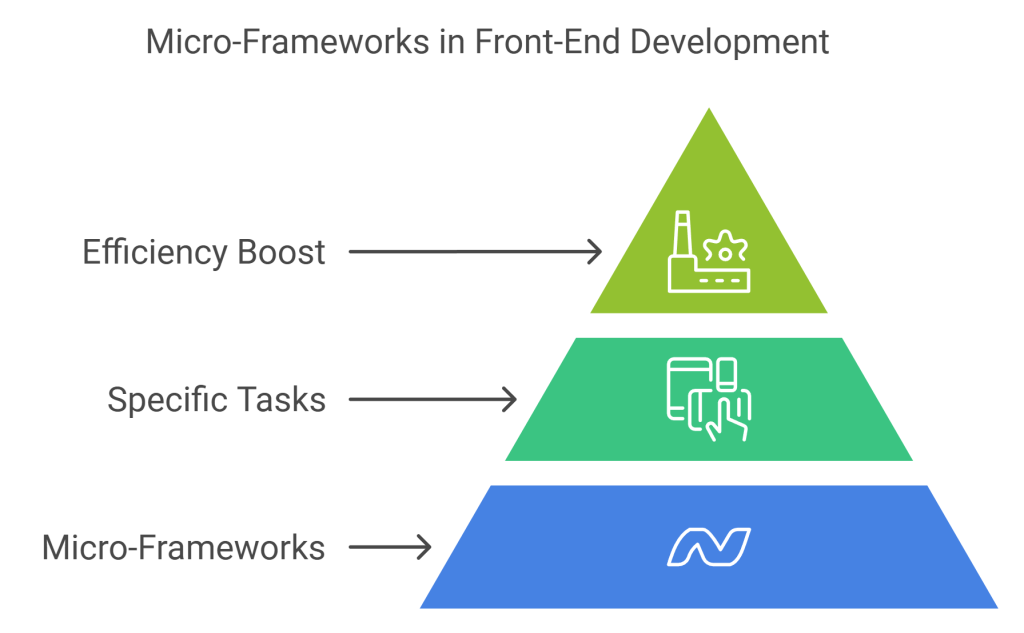
- Bottle: A minimalist framework that works well for building small, simple web applications with custom front-end needs.
- Dash: Designed for data visualization, Dash is perfect for creating interactive dashboards and apps with Python as the main language.
Strengths and Challenges
Python frameworks offer simplicity and flexibility, making them great for beginners and experts. They allow you to use Python for both back-end and front-end tasks. However, since Python is not as widely supported in browsers as JavaScript, some frameworks may have limitations for high-performance front-end needs.
By exploring these frameworks, you can find the one that fits your project best, whether you’re focusing on a user-friendly interface, a data-driven app, or a full-stack solution.
Unique Challenges of Python in Front-End Development
Using Python for front-end development can be exciting, but it comes with its challenges. The biggest challenge is the lack of native browser support. Unlike JavaScript, which is built into every browser and works seamlessly, Python isn’t designed to run directly in browsers. This is where JavaScript Frontend Frameworks have a clear advantage, as they are optimized for browser-based tasks. To make Python work on the front end, developers rely on extra tools like PyScript or Brython to bridge the gap.
Thankfully, tools like PyScript and Brython help bridge this gap. PyScript lets you write
Python code directly in HTML, making it easier to add Python functionality to your front end. Brython converts Python into JavaScript so it can run in the browser, giving you the flexibility of using Python while ensuring compatibility.
While these tools are powerful, they aren’t perfect. They might not be as fast as JavaScript for highly interactive or performance-heavy tasks. However, they are great options for developers who prefer Python and want to use it for both front-end and back-end development.
Despite the challenges, Python front-end frameworks are evolving quickly. With the right tools and an understanding of these limitations, you can still build impressive and interactive web projects.
Top Python Front-End Frameworks to Enhance Development
Python has some amazing front-end frameworks that make web development easier and more efficient. These frameworks let you use Python to create user-friendly websites and applications. Here’s a closer look at some of the best options available:
1. PyScript: Embedding Python in HTML
PyScript allows you to write Python code directly inside HTML files. This means you can create interactive apps without needing JavaScript. It’s perfect for beginners who prefer Python’s simple syntax and want to build web apps quickly. PyScript is also great for small projects or experimenting with Python in the browser.
2. Brython: Translating Python into JavaScript
Brython converts Python code into JavaScript so it can run smoothly in web browsers. It’s an excellent choice for developers who prefer Python but still need compatibility with browser environments. Brython makes it easier to create dynamic front-end features while using Python’s readable and concise code style.
3. Anvil: Simplifying Web App Development
Anvil is a full-stack framework designed to make web app development easy. It provides drag-and-drop tools to design your front-end interface, along with Python code for back-end functionality. You don’t need to worry about writing HTML, CSS, or JavaScript. Anvil handles everything, making it ideal for those who want an all-in-one Python solution.
4. Dash: Building Interactive Dashboards
Dash is perfect for creating interactive dashboards and data-driven applications. It’s widely used for projects that require visualizing data, like reports or analytics tools. With Dash, you can easily combine Python’s data-handling power with a sleek, interactive front end.
5. Tornado and Falcon: Lightweight Front-End Needs
Both Tornado and Falcon are known for their speed and efficiency. While they are primarily used for back-end development, they can also handle lightweight front-end tasks. These frameworks are a great option if your project doesn’t require a complex user interface but still needs fast and reliable performance.
Strengths and Considerations
Each of these frameworks has its strengths. PyScript and Brython make Python accessible in browsers, while Anvil provides a complete package for app development. Dash stands out for data visualization, and Tornado and Falcon are great for simple, speedy projects. However, Python frameworks may not always match JavaScript’s performance for intensive front-end tasks.
The right framework can make web development with Python easier and more fun. Take a look at these tools to find the one that works best for your needs.
Innovations in Python Front-End Development
Python, traditionally a back-end powerhouse, is making strides in front-end development. New tools and technologies are helping Python become more competitive in creating user-friendly and interactive web applications. Let’s explore these exciting innovations:
1. New Tools and Technologies
Several new tools have been developed to make Python a strong choice for front-end work. Frameworks like PyScript and Brython allow Python code to run directly in web browsers. These tools eliminate the need for switching between Python and JavaScript, simplifying the development process. Additionally, platforms like Anvil provide an all-in-one solution for building entire web applications with Python, from front-end design to back-end functionality.
2. Use of WebAssembly (Wasm)
One of the biggest game-changers is WebAssembly (Wasm). Wasm allows Python to run in browsers at near-native speeds, making it a viable alternative to JavaScript for performance-critical tasks. Tools like Pyodide leverage Wasm to execute Python scripts directly in the browser, opening up possibilities for building fast and interactive web applications entirely in Python. This technology is still evolving, but it’s already a big step forward for Python in the front-end space.
3. Integration with JavaScript Libraries
Python is also becoming more flexible through hybrid development. It can integrate with popular JavaScript libraries like React or Vue.js. This means you can use Python for back-end processing and pair it with JavaScript for the front-end interface. Some tools even let you mix Python and JavaScript seamlessly, giving developers the best of both worlds.
Benefits of Using Python for Front-End Development
Python is a popular language for back-end development, but its use in front-end tasks is growing. This makes Python a unique option for developers who want simplicity and flexibility across the entire development process. Let’s explore the key benefits of using Python for front-end development.
Unified Coding Language for Back-End and Front-End
One of Python’s biggest advantages is its ability to work on both the back-end and front-end. Instead of learning and using separate languages like Python for the server side and JavaScript for the client side, you can rely on Python for the entire project. This approach saves time and effort, reduces complexity, and makes your codebase easier to manage. Teams also benefit since everyone works with the same language, improving collaboration and debugging.
Easier Prototyping for Data-Centric or Scientific Apps
Python is known for its strong data-handling capabilities, which is why it’s widely used in data science and analytics. When building data-centric or scientific web apps, frameworks like Dash and Flask make it easy to create prototypes quickly. These tools allow you to focus on showing insights and functionality without learning complex front-end design skills. This is especially useful for researchers, analysts, and developers with data visualizations or interactive dashboards.
Reduced Learning Curve for Python Developers Transitioning to Front-End
For developers who already know Python, moving into front-end development can feel daunting because of the need to learn JavaScript, HTML, and CSS. But with frameworks like PyScript and Brython, Python can now handle many front-end tasks. These tools allow you to use Python syntax to build interactive web pages, making it easier to start. You can focus on building features without getting stuck on unfamiliar syntax, speeding up your progress.
Using Python for front-end development makes the process simpler and more organized. It’s a great option for developers who want to speed up their workflow and build prototypes quickly. If you already know Python, you can use your existing skills to try new things in web development. While Python isn’t likely to fully replace JavaScript, it’s an excellent choice for creating user-friendly, data-focused applications without much hassle.
Testing and Optimizing Python Front-End Frameworks
When building front-end applications using Python, testing and optimization are key steps to ensure your project works smoothly and looks great on all devices. Let’s explore how to test Python-based front-end apps effectively and make them perform their best.
Testing Python Websites on Real Devices
Testing your website on real devices helps you understand how it looks and functions in the real world. While simulators and emulators can help, they don’t always show real-world issues like touch responsiveness or screen resolutions. Platforms like BrowserStack allow you to test your Python-based websites on a variety of devices and browsers without needing to own them all. It’s a simple way to catch potential problems early.
Cross-Browser Compatibility Testing
Websites need to work consistently across different browsers like Chrome, Firefox, and Safari. Python front-end frameworks often interact with these browsers in unique ways. Tools like BrowserStack or Selenium can help you test for cross-browser compatibility. These tools ensure your app works the same way, no matter what browser your users prefer.
Performance Optimization Tips
To make your Python front-end app load faster and run more smoothly:
- Minimize Code Size: Remove unnecessary code and compress your files. This helps your website load faster.
- Use Caching: Store frequently used data locally to reduce load times. Tools like Flask’s built-in caching system can help.
- Optimize Images: Large images can slow down your website. Use formats like WebP or tools to compress image sizes without losing quality.
- Lazy Loading: Load only the parts of your website that users need right away. This can improve speed and user experience.
- Asynchronous Requests: When fetching data, use asynchronous calls to keep your app responsive and smooth.
Why Testing and Optimizing Matters
Testing and optimizing your Python front-end app ensures a better user experience. It also makes your website faster and more reliable. By using the right tools and strategies, you can avoid common issues and deliver a polished product that works well for all users.
Taking time to test and optimize isn’t just about fixing problems. It’s about making sure your app stands out and performs its best in today’s competitive web environment.
Related Article – Top Front-End Testing Frameworks in 2025 for Reliable Web Applications
Choosing the Best Python Framework for Your Project
Choosing the right Python framework is important for making your project successful. The best framework depends on your project’s needs, your team’s skills, and how much you expect the app to grow in the future. Here’s how to make the right choice.
Factors to Consider
- Project Size and Complexity
Small projects or quick prototypes work well with simple frameworks like Flask or Bottle. These are easy to use and let you focus on specific features without much setup. For bigger projects, go for a full-stack framework like Django. It includes built-in tools for tasks like managing databases and user authentication. - Team’s Experience
If your team knows Python but isn’t familiar with front-end development, start with tools like PyScript or Brython. These frameworks let you use Python for the front end, so you don’t need to learn JavaScript right away. - Scalability
For apps that need to handle a lot of users or complex tasks, use frameworks built for scalability. Frameworks like Tornado or FastAPI are perfect for building fast, high-performing web applications. They’re great for apps that process a lot of data or work in real-time.
Python vs. JavaScript Frameworks
JavaScript frameworks like React, Angular, and Vue.js are popular for creating interactive user interfaces. They offer lots of tools and a huge ecosystem for front-end development.
On the other hand, Python frameworks like Anvil and Dash focus on simplicity. They’re great for developers who know Python and want to build apps quickly. These are especially useful for creating dashboards, data visualizations, or apps that need both front-end and back-end functionality.
Combining Python and JavaScript
Sometimes, using both Python and JavaScript is the best option. Here’s how to do it:
- Divide Work: Use Python for back-end tasks like data processing and JavaScript for creating interactive front-end interfaces.
- Use APIs: Build an API with frameworks like Flask or Django, and use JavaScript to fetch and display data on the front end.
- Try WebAssembly: Tools like Pyodide allow you to run Python code in the browser, making combining Python and JavaScript in your project easier.
How to Decide
The framework you choose should fit your needs. Start with simple frameworks if you’re new to web development. For complex projects, pick something more robust with built-in features. And if you want the best of both worlds, combine Python and JavaScript for a flexible and powerful solution.
By thinking about these factors, you can pick a framework that makes development easier and helps your project succeed.
Let’s Bring Your Ideas to Life
At Boomdevs, we create custom apps and websites that fit your needs perfectly. Whether it’s a business site, an e-commerce platform, or a feature-rich app, we’re here to help. Our team uses the latest technologies, including Python Front-End Frameworks, to build solutions that are modern, reliable, and easy to use. Whatever your vision is, we’ll turn it into a reality.
Why Choose Boomdevs?
We are Boomdevs care about your success. At Boomdevs, we don’t just make apps or websites—we create tools that help your business grow. From start to finish, we support you at every step. With our skills in Python Front-End Frameworks, we can handle all your web development needs. Have a specific idea? No problem. Our team listens, advises, and delivers exactly what you need. You can count on us for quality work you’ll love.
Let’s Get Started! Contact Us Today
FAQ
1. What are Python front-end frameworks?
Python front-end frameworks are tools that allow developers to use Python for creating the visible and interactive parts of a website. These frameworks help design user interfaces, buttons, forms, and layouts that users interact with directly.
2. Can Python be used for front-end web development?
Yes, while Python is mostly known for back-end development, frameworks like PyScript, Brython, and Anvil make it possible to use Python for front-end tasks. These tools bridge the gap between Python and browser-based development.
3. What are the top Python front-end frameworks?
Some popular Python front-end frameworks include:
- PyScript: Embeds Python in HTML for interactive apps.
- Brython: Converts Python into JavaScript for browser execution.
- Anvil: Offers a drag-and-drop interface for web app design.
- Dash: Ideal for creating data-driven dashboards.
- Bottle and Tornado: Lightweight options for front-end needs.
4. How do Python front-end frameworks compare to JavaScript frameworks?
JavaScript frameworks like React and Angular dominate front-end development due to their browser-native support. Python front-end frameworks are less common but are excellent for developers who prefer using Python or need to integrate with data-heavy back-end processes.
5. What are the benefits of Python front-end frameworks?
- Unified language for back-end and front-end development.
- Easier prototyping for data-centric applications.
- Reduced learning curve for Python developers exploring front-end tasks.
6. What challenges do Python front-end frameworks face?
The main challenges include the lack of native browser support for Python and reliance on tools like PyScript or Brython to bridge this gap. These frameworks may also have smaller communities compared to JavaScript frameworks.
7. Is Python suitable for building data-driven web apps?
Yes, Python excels in building data-driven applications. Frameworks like Dash and Anvil are specifically designed for creating interactive dashboards and scientific web apps using Python.
8. What trends are shaping Python’s role in front-end development?
Emerging tools, the use of WebAssembly (Wasm) for running Python in browsers, and hybrid integration with JavaScript libraries are shaping Python’s future in front-end development.
9. How can I choose the best Python framework for my project?
Consider the size of your project, your team’s skills, and scalability needs. For simpler projects, lightweight frameworks like Bottle work well. For more robust applications, full-stack frameworks like Django or Flask with front-end capabilities are better.
10. Where can I get professional help for web development using Python?
At Boomdevs, we specialize in custom app and web development, including using Python for both front-end and back-end needs. Our experienced team can help bring your vision to life with tailored solutions.
Final Thought
Python front-end frameworks make it easier to create interactive and user-friendly websites. Tools like PyScript let you add Python to HTML, while Dash helps build dashboards for data-driven projects.
These frameworks show that Python can be useful for web development, even though JavaScript is more common.
If you’re working on a big project, Django is a great option. For smaller tasks, Bottle is simple and efficient. Python’s front-end tools are easy to use and perfect for data-focused work.
Start exploring them today to improve your web development process!



